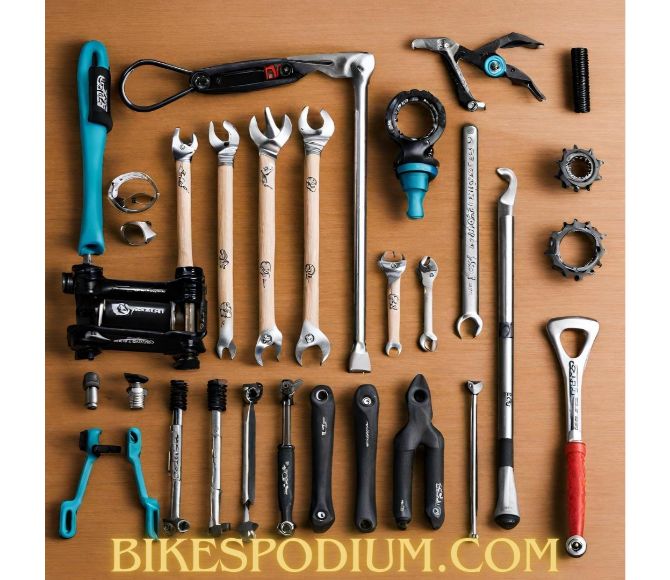
When it comes to going on a bike ride, it’s essential to have the right tools and equipment to ensure a smooth and enjoyable experience.
Whether you’re a casual rider or a seasoned cyclist, having the necessary tools at hand can make a significant difference in your biking journey.
In this article, we will explore the essential tools that every cyclist should have before hitting the road.
1. Bike Pump
A bike pump is an absolute must-have tool for any cyclist. It allows you to inflate your bike tires to the recommended pressure, ensuring optimal performance and a comfortable ride.
There are various types of bike pumps available, including floor pumps, hand pumps, and mini pumps.
It’s advisable to invest in a portable and lightweight pump that you can easily carry with you on your rides.
Having the right bike pump is crucial because:
- Proper tire pressure improves traction and reduces the risk of punctures.
- Underinflated tires can make pedaling more difficult and decrease efficiency.
- Overinflated tires can lead to a harsh ride and increase the risk of a blowout.
Consider the following factors when choosing a bike pump:
- Type of valve: Ensure that the pump is compatible with the valve type on your bike tires.
- Size and weight: Opt for a pump that is easy to carry and store on your bike.
- Pressure gauge: A built-in pressure gauge allows you to accurately inflate your tires to the recommended level.
2. Tire Repair Kit
No matter how cautious you are, a flat tire can happen unexpectedly.
That’s why it’s crucial to have a tire repair kit handy. This kit typically includes tire levers, patches, and adhesive.
Tire levers help you remove the tire from the rim, while patches and adhesive allow you to fix punctures and get back on the road quickly.
It’s wise to practice using the tire repair kit at home before your ride to become familiar with the process.
A tire repair kit is essential because:
- Flat tires are a common occurrence during bike rides, especially on rough terrain.
- Being able to repair a puncture quickly can save you time and frustration.
- It allows you to continue your ride without having to rely on external assistance.
Here’s what you should include in your tire repair kit:
- Tire levers: These tools help you remove the tire from the rim without damaging it.
- Patches and adhesive: Use these to fix punctures in the inner tube.
- Sandpaper: Roughen the area around the puncture for better adhesion.
- Spare inner tubes: In case the puncture is too large to repair with a patch, having spare tubes ensures that you can replace the damaged tube and continue your ride.
3. Multitool
A multitool is a versatile tool that combines several functions in one compact device. It usually includes Allen wrenches, screwdrivers, and a chain tool.
These tools can be extremely useful in making minor adjustments, tightening screws, or fixing your bike’s chain.
Investing in a high-quality multitool ensures you have all the necessary tools conveniently packed in one place.
A multitool is essential because:
- It allows you to make on-the-go repairs and adjustments without carrying a toolbox.
- Different bike components require various tools, and a multitool provides a compact solution.
- It saves space and reduces the weight of your gear, making it easier to carry during rides.
Consider the following features when choosing a multitool:
- Allen wrenches: Look for a multitool with a variety of sizes to fit different bolts on your bike.
- Screwdrivers: Ensure that the multitool includes flathead and Phillips screwdrivers for various screws on your bike.
- Chain tool: This tool is necessary for fixing or replacing a broken chain during a ride.
4. Spare Tubes
Carrying spare tubes is essential, especially during long rides or when riding in remote areas.
A flat tire can easily ruin your biking experience, but having spare tubes can save you from being stranded.
Ensure that you carry the correct tube size for your bike, and it’s a good idea to pack at least two spare tubes to be prepared for multiple flats.
Why carrying spare tubes is important:
- Flat tires are more common during long rides, and having spare tubes allows for quick replacement.
- In remote areas, finding a bike shop or assistance may not be readily available.
- Having multiple spare tubes ensures that you can continue your ride even if you encounter multiple flats.
Consider the following when choosing spare tubes:
- Tube size: Ensure that the spare tubes match the tire size and valve type of your bike.
- Quality: Invest in puncture-resistant tubes to reduce the risk of flats.
- Valve type: Check whether your bike has a Presta or Schrader valve and choose the appropriate spare tubes.
5. Chain Lubricant
Proper maintenance of your bike’s chain is crucial for its longevity and smooth operation.
Applying chain lubricant regularly helps reduce friction, improve shifting performance, and prevent rust.
Carry a small bottle of chain lubricant with you on your rides, and apply it to your chain when necessary, especially after riding in wet or muddy conditions.
Why chain lubricant is important:
- Lubricating the chain reduces friction between the moving parts, extending its lifespan.
- It improves shifting performance and ensures smooth gear changes.
- Prevents rust and corrosion, especially when riding in wet or muddy conditions.
Consider the following when choosing chain lubricant:
- Wet or dry conditions: Use wet lubricant for wet conditions and dry lubricant for dry conditions.
- Application method: Some lubricants come in spray bottles, while others require manual application.
- Frequency of application: Follow the manufacturer’s instructions on how often to apply the lubricant.
6. Bike Lights
If you plan on cycling during low-light conditions or at night, having bike lights is essential for your safety.
Front and rear lights increase your visibility to other road users, allowing them to see you from a distance.
Choose lights with a long battery life or opt for rechargeable ones to ensure they don’t run out of power during your ride.
Why bike lights are essential:
- They improve your visibility to motorists, pedestrians, and other cyclists.
- Enhance safety by reducing the risk of accidents, especially in low-light or nighttime conditions.
- Many countries have laws requiring cyclists to use lights during specific hours or low-light conditions.
Consider the following when choosing bike lights:
- Brightness: Look for lights with high lumens to ensure maximum visibility.
- Battery life: Opt for lights with long battery life or consider rechargeable lights.
- Mounting options: Ensure that the lights are easy to attach and detach from your bike.
7. Water Bottle Cage
Staying hydrated is vital during any physical activity, including cycling. A water bottle cage attached to your bike frame allows you to carry a water bottle securely.
It enables you to hydrate yourself conveniently without needing to stop frequently. Ensure that your water bottle cage is compatible with the size of your water bottle and securely holds it in place.
Why a water bottle cage is important:
- Hydration is necessary to maintain performance and avoid dehydration during rides.
- A water bottle cage provides easy access to water without interrupting your ride.
- It keeps your hands free and allows you to maintain control of the bike while drinking.
Consider the following when choosing a water bottle cage:
- Compatibility: Ensure that the cage fits the diameter and shape of your water bottle.
- Material: Look for a cage made of lightweight and durable material, such as aluminum or carbon fiber.
- Secure attachment: Make sure the cage securely holds the water bottle and doesn’t cause any rattling or movement during the ride.
8. First Aid Kit
Accidents can happen, and it’s always better to be prepared. Carrying a compact first aid kit can be a lifesaver in case of minor injuries or emergencies.
Include items such as adhesive bandages, antiseptic wipes, gauze pads, and medical tape. It’s essential to know how to use the items in your first aid kit correctly, so consider taking a basic first aid course.
Why a first aid kit is crucial:
- It allows you to provide immediate care for minor injuries, reducing the risk of infection or further complications.
- In case of emergencies, a first aid kit can help stabilize the situation until professional medical help arrives.
- It gives you peace of mind knowing that you’re prepared to handle unexpected situations.
Consider the following when assembling a first aid kit:
- Basic items: Include adhesive bandages, antiseptic wipes, gauze pads, medical tape, and gloves.
- Personal medication: If you have any specific medical conditions, carry any necessary medication in your first aid kit.
- Familiarize yourself: Learn how to use the items in your kit effectively by taking a basic first aid course.
9. Bike Lock
Whenever you need to leave your bike unattended, having a reliable bike lock is crucial.
A sturdy bike lock helps protect your bike from theft and provides peace of mind while you’re away.
Choose a lock that is difficult to cut or break, ensuring the security of your bike.
Why a bike lock is necessary:
- Bike theft is a common occurrence, and using a lock significantly reduces the risk.
- A locked bike deters potential thieves and makes it more challenging for them to steal your bike.
- It provides peace of mind, allowing you to leave your bike unattended without worrying about its safety.
Consider the following when choosing a bike lock:
- Security level: Look for locks with high-security ratings, such as those certified by independent organizations.
- Lock type: Choose between U-locks, chain locks, or cable locks based on your specific needs and preferences.
- Size and weight: Consider the portability of the lock and whether it’s suitable for your riding style.
10. Cycling Gloves
Cycling gloves offer several benefits, making them an important addition to your biking gear.
They provide cushioning and improve grip, reducing the risk of hand fatigue and blisters.
Additionally, cycling gloves offer protection in case of a fall, minimizing the chances of abrasions and cuts.
Why cycling gloves are beneficial:
- Cushioning: Gloves with padding or gel inserts absorb shock and vibrations, reducing hand fatigue during long rides.
- Grip enhancement: The material on the palms improves your grip on the handlebars, enhancing control and reducing the risk of slipping.
- Protection: In case of a fall, gloves can prevent or minimize injuries to the hands, such as abrasions or cuts.
Consider the following when choosing cycling gloves:
- Fit: Ensure that the gloves fit snugly but comfortably, allowing for proper hand movement and dexterity.
- Padding: Look for gloves with adequate padding in the palm area to provide cushioning.
- Breathability: Opt for gloves made of breathable materials to prevent excessive sweating and discomfort.
Remember, safety should always be a priority when cycling. Apart from these essential tools, it’s also important to wear a properly fitted helmet and appropriate cycling attire.
Regularly check your bike’s brakes, gears, and tire pressure before heading out for a ride. By being well-prepared with the right tools and equipment, you can ensure a comfortable, enjoyable, and safe biking experience. Happy cycling!
FAQ
1. Why is a bike pump essential for every cyclist?
A bike pump is essential because it allows you to inflate your bike tires to the recommended pressure, improving traction, reducing the risk of punctures, and ensuring a comfortable ride.
2. Why is a tire repair kit important for cyclists?
A tire repair kit is important because it helps you fix punctures quickly, saving you time and frustration. It allows you to continue your ride without relying on external assistance.
3. Why should cyclists invest in a multitool?
Cyclists should invest in a multitool because it provides the necessary tools for on-the-go repairs and adjustments. It is compact, saves space, and reduces the weight of your gear.
4. Why should cyclists carry spare tubes?
Cyclists should carry spare tubes because flat tires are common during long rides, especially in remote areas. Having spare tubes allows for quick replacement and ensures that you can continue your ride even if you encounter multiple flats.



